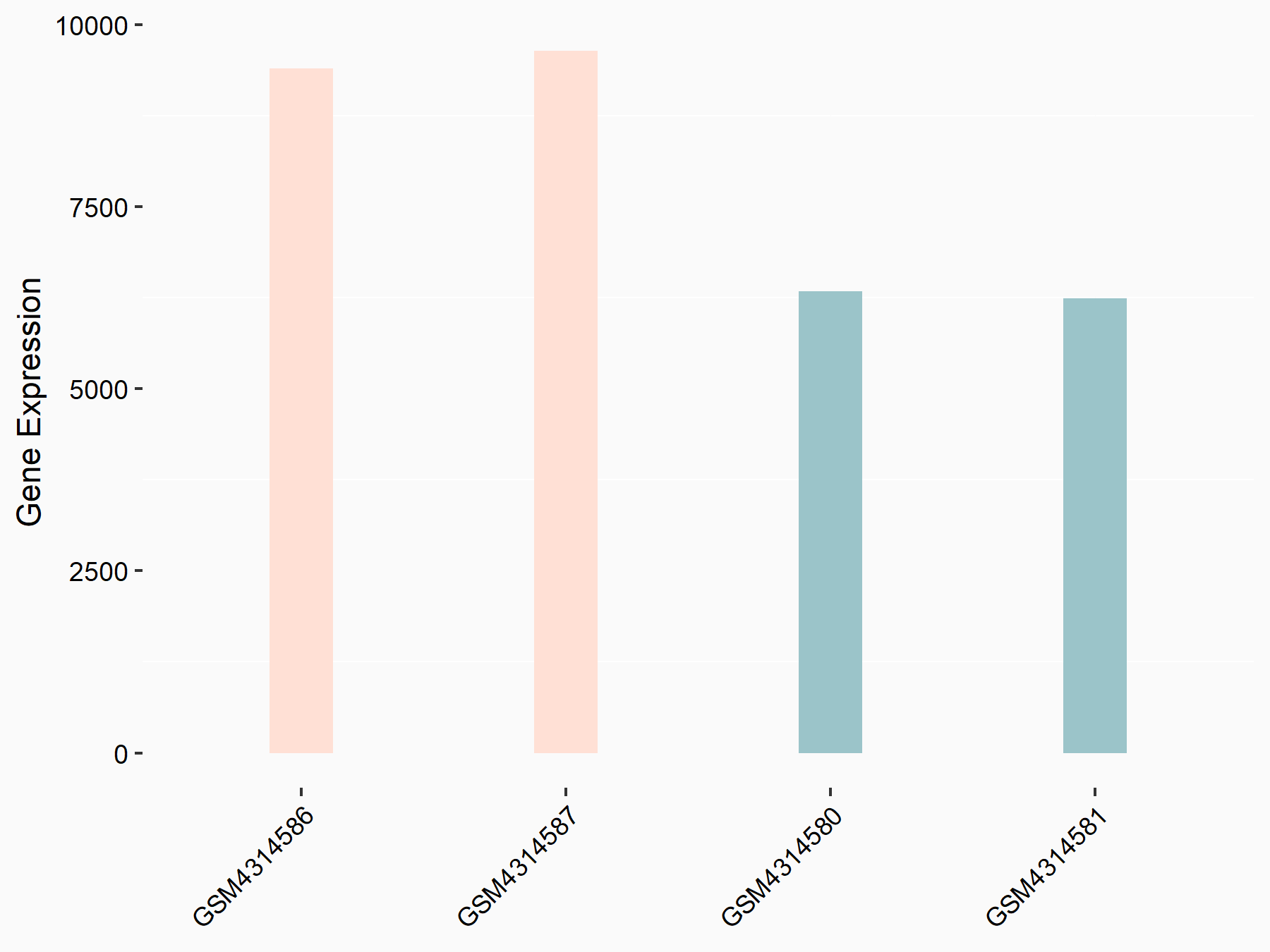m6A Target Gene Information
General Information of the m6A Target Gene (ID: M6ATAR00554)
Full List of m6A Methylation Regulator of This Target Gene and Corresponding Disease/Drug Response(s)
Fak
can be regulated by the following regulator(s), and cause disease/drug response(s). You can browse detail information of regulator(s) or disease/drug response(s).
Browse Regulator
Browse Disease
Browse Drug
Wilms tumor 1-associating protein (WTAP) [WRITER]
| Representative RNA-seq result indicating the expression of this target gene regulated by WTAP | ||
| Cell Line | mouse embryonic stem cells | Mus musculus |
|
Treatment: WTAP-/- ESCs
Control: Wild type ESCs
|
GSE145309 | |
| Regulation |
  |
logFC: 5.98E-01 p-value: 1.29E-24 |
| More Results | Click to View More RNA-seq Results | |
| In total 1 item(s) under this regulator | ||||
| Experiment 1 Reporting the m6A Methylation Regulator of This Target Gene | [1] | |||
| Response Summary | WTAP could promote migration/invasion and suppress chemo-sensitivity to gemcitabine in PC. Further mechanical investigation revealed that WTAP could bind to and stabilize Focal adhesion kinase 1 (Fak) mRNA which in turn activated the Fak-PI3K-AKT and Fak-Src-GRB2-Erk1/2 signaling pathways. | |||
| Target Regulation | Up regulation | |||
| Responsed Disease | Pancreatic cancer | ICD-11: 2C10 | ||
| Responsed Drug | Gemcitabine | Approved | ||
| Pathway Response | PI3K-Akt signaling pathway | hsa04151 | ||
| Cell Process | RNA stability | |||
| In-vitro Model | T3M-4 | Pancreatic ductal adenocarcinoma | Homo sapiens | CVCL_4056 |
| PANC-1 | Pancreatic ductal adenocarcinoma | Homo sapiens | CVCL_0480 | |
| MIA PaCa-2 | Pancreatic ductal adenocarcinoma | Homo sapiens | CVCL_0428 | |
| hTERT-HPNE | Normal | Homo sapiens | CVCL_C466 | |
| HPDE6c7 | Normal | Homo sapiens | CVCL_0P38 | |
| BxPC-3 | Pancreatic ductal adenocarcinoma | Homo sapiens | CVCL_0186 | |
| AsPC-1 | Pancreatic ductal adenocarcinoma | Homo sapiens | CVCL_0152 | |
| In-vivo Model | Twenty-four female BALB/c athymic nude mice, which were 4-6 weeks old and weighed 20.0-25.0 g, were obtained from the Animal Research Center of PUMCH. WTAP-OE, WTAP-NC, shWTAP and shNC-lentivirus infected MIA PaCa-2 cells (5 × 106) were suspended in 50 uL PBS and then injected subcapsularly into the pancreatic tissue by 1-mL syringes. | |||
Pancreatic cancer [ICD-11: 2C10]
| In total 1 item(s) under this disease | ||||
| Experiment 1 Reporting the m6A-centered Disease Response | [1] | |||
| Response Summary | WTAP could promote migration/invasion and suppress chemo-sensitivity to gemcitabine in PC. Further mechanical investigation revealed that WTAP could bind to and stabilize Focal adhesion kinase 1 (Fak) mRNA which in turn activated the Fak-PI3K-AKT and Fak-Src-GRB2-Erk1/2 signaling pathways. | |||
| Responsed Disease | Pancreatic cancer [ICD-11: 2C10] | |||
| Target Regulator | Wilms tumor 1-associating protein (WTAP) | WRITER | ||
| Target Regulation | Up regulation | |||
| Responsed Drug | Gemcitabine | Approved | ||
| Pathway Response | PI3K-Akt signaling pathway | hsa04151 | ||
| Cell Process | RNA stability | |||
| In-vitro Model | T3M-4 | Pancreatic ductal adenocarcinoma | Homo sapiens | CVCL_4056 |
| PANC-1 | Pancreatic ductal adenocarcinoma | Homo sapiens | CVCL_0480 | |
| MIA PaCa-2 | Pancreatic ductal adenocarcinoma | Homo sapiens | CVCL_0428 | |
| hTERT-HPNE | Normal | Homo sapiens | CVCL_C466 | |
| HPDE6c7 | Normal | Homo sapiens | CVCL_0P38 | |
| BxPC-3 | Pancreatic ductal adenocarcinoma | Homo sapiens | CVCL_0186 | |
| AsPC-1 | Pancreatic ductal adenocarcinoma | Homo sapiens | CVCL_0152 | |
| In-vivo Model | Twenty-four female BALB/c athymic nude mice, which were 4-6 weeks old and weighed 20.0-25.0 g, were obtained from the Animal Research Center of PUMCH. WTAP-OE, WTAP-NC, shWTAP and shNC-lentivirus infected MIA PaCa-2 cells (5 × 106) were suspended in 50 uL PBS and then injected subcapsularly into the pancreatic tissue by 1-mL syringes. | |||
Gemcitabine
[Approved]
| In total 1 item(s) under this drug | ||||
| Experiment 1 Reporting the m6A-centered Drug Response | [1] | |||
| Response Summary | WTAP could promote migration/invasion and suppress chemo-sensitivity to gemcitabine in PC. Further mechanical investigation revealed that WTAP could bind to and stabilize Focal adhesion kinase 1 (Fak) mRNA which in turn activated the Fak-PI3K-AKT and Fak-Src-GRB2-Erk1/2 signaling pathways. | |||
| Target Regulator | Wilms tumor 1-associating protein (WTAP) | WRITER | ||
| Target Regulation | Up regulation | |||
| Responsed Disease | Pancreatic cancer | ICD-11: 2C10 | ||
| Pathway Response | PI3K-Akt signaling pathway | hsa04151 | ||
| Cell Process | RNA stability | |||
| In-vitro Model | T3M-4 | Pancreatic ductal adenocarcinoma | Homo sapiens | CVCL_4056 |
| PANC-1 | Pancreatic ductal adenocarcinoma | Homo sapiens | CVCL_0480 | |
| MIA PaCa-2 | Pancreatic ductal adenocarcinoma | Homo sapiens | CVCL_0428 | |
| hTERT-HPNE | Normal | Homo sapiens | CVCL_C466 | |
| HPDE6c7 | Normal | Homo sapiens | CVCL_0P38 | |
| BxPC-3 | Pancreatic ductal adenocarcinoma | Homo sapiens | CVCL_0186 | |
| AsPC-1 | Pancreatic ductal adenocarcinoma | Homo sapiens | CVCL_0152 | |
| In-vivo Model | Twenty-four female BALB/c athymic nude mice, which were 4-6 weeks old and weighed 20.0-25.0 g, were obtained from the Animal Research Center of PUMCH. WTAP-OE, WTAP-NC, shWTAP and shNC-lentivirus infected MIA PaCa-2 cells (5 × 106) were suspended in 50 uL PBS and then injected subcapsularly into the pancreatic tissue by 1-mL syringes. | |||